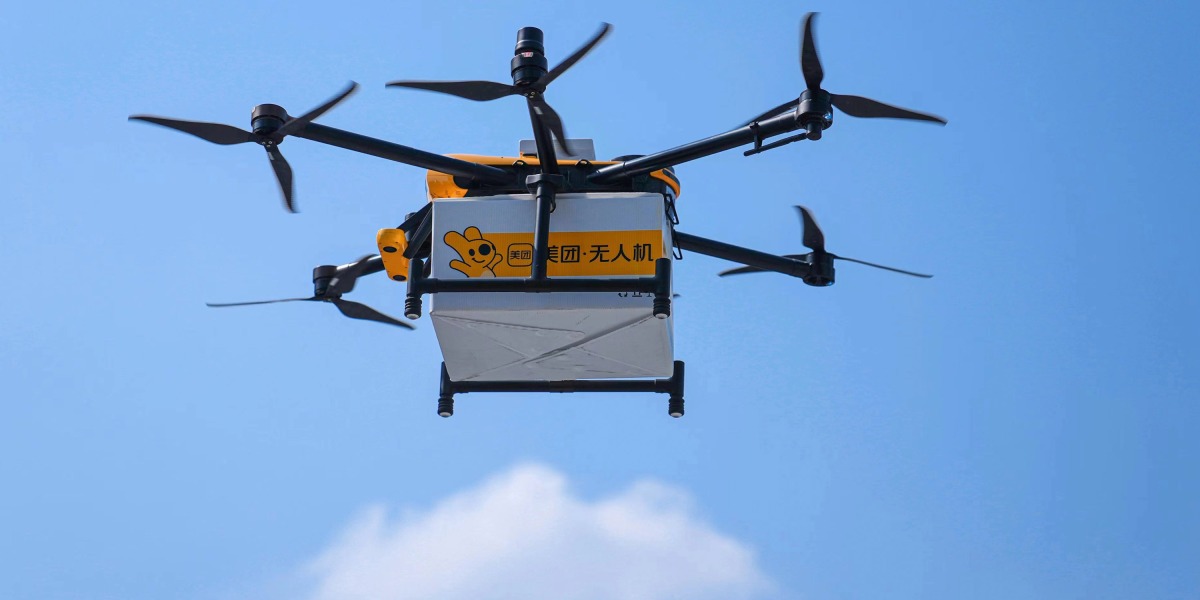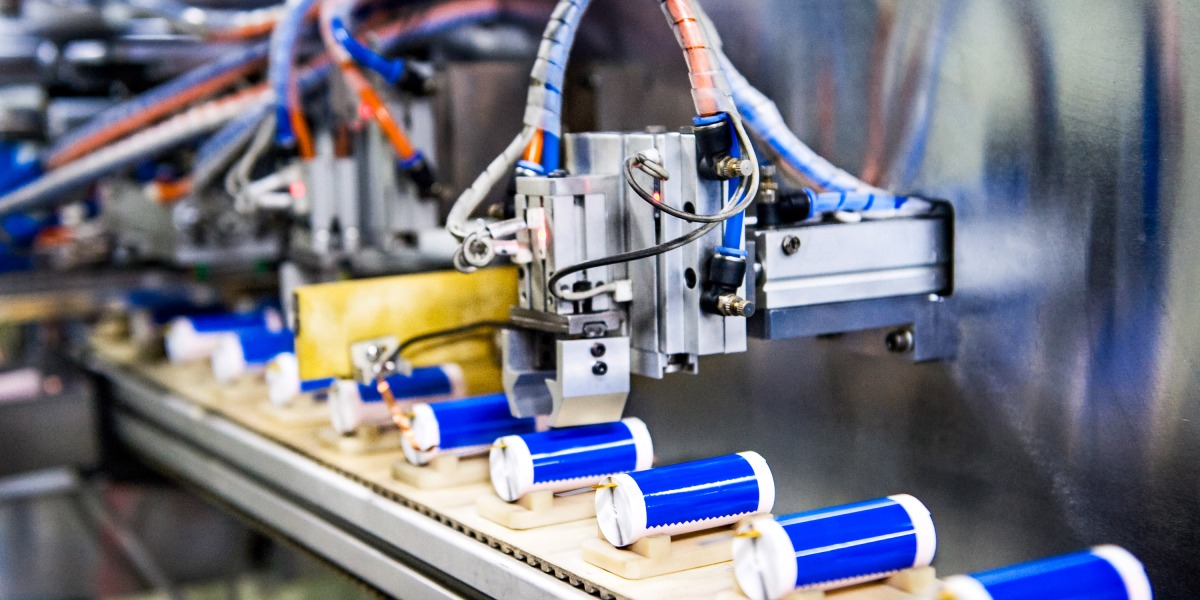Food delivery by drone is just part of daily life in Shenzhen
My iced tea arrived from the sky.
In a buzzy urban area in Shenzhen, China, sandwiched between several skyscrapers, I watched as a yellow-and-black drone descended onto a pickup kiosk by the street. The top of the vending-machine-size kiosk opened up for the drone to land, and a white cardboard box containing my drink was placed inside. When I had made the delivery order on my phone half an hour before, the app noted that it would arrive by drone at 2:03 p.m., and that was exactly when it came.
The drone delivery service I was trying out is operated by Meituan, China’s most popular food delivery platform. In 2022, the company engaged some 6 million gig delivery workers to deliver billions of orders. But the company has also been developing drone delivery since 2017. And in Shenzhen, a southern city that’s home to a mature drone supply chain, Meituan has been regularly operating such delivery routes for the last year and a half.
Many big corporations have had their eyes on drone delivery: Amazon first proposed doing it in 2013, but its progress has been limited by regulations and a lack of demand. Wing, owned by Google’s parent company Alphabet, has had more success, operating drone deliveries on three continents. And Walmart is backing several drone startups to experiment with delivering its products.
What differentiates Meituan from these American peers is that it has chosen to offer drone delivery in what is potentially the most challenging environment: dense urban neighborhoods. It’s an approach that makes sense in China, where most people live in high-rise apartment buildings in populous cities, and many of them order food delivery on a daily basis.
To make the service work in a dense city, Meituan doesn’t have the drones deliver directly to your doorstep. Instead, the company has set up pickup kiosks close to residential or office buildings. Drones drop off deliveries at the kiosks, which can hold several packages at once. The process may be less convenient for customers, but it allows every drone to fly a predetermined route, from one launchpad to one kiosk, making the task of navigating urban areas much easier.
In 2022, Meituan made more than 100,000 drone deliveries in Shenzhen. My own experience wasn’t seamless. The first time I tried to use the service, I accidentally ordered from a restaurant that was too far away. My second attempt failed because I had unwittingly ordered after hours (the drones go to bed at 7 p.m.).
But for some Shenzhen residents and vendors, delivery by drone is no longer a novelty—it’s just part of their daily routine. Meituan’s progress shows that regular drone delivery in cities is possible, even though it requires making some compromises when it comes to user experience. How does the magic happen? I visited one of the company’s drone launchpads to see how it’s done.
The rooftop “airport”
Meituan launches its drones in Shenzhen from five delivery hubs. My tea actually came from one that was only a few hundred feet away, on the rooftop of a gigantic shopping mall. There, the building’s rooftop has been turned into an airport for the drones and a handful of support staff.
When I visited in April, there were about 10 drones parked on the rooftop, and two or three either taking off or landing. I had just missed the lunch peak, I was told by a Meituan employee, and the drones and humans there were mostly resting and recharging in anticipation of the dinner peak.
The workflow is a mix of human and automated labor. Once the drone delivery system gets an order (customers order specific items marked for drone delivery in the company’s app), a runner (human) goes to the restaurants, all located a few flights down in the shopping mall, to pick up the order and brings it to the launchpad. The runner places the food and drinks in a standardized cardboard box, weighs it to make sure it’s not too heavy, seals the box, and hands it off to a different worker who specializes in dealing with the drones. The second worker places the box under a drone and waits for it to lock in.
Everything after that is highly automated, says Mao Yinian, the director of drone delivery services at Meituan. The drones’ movements are controlled by a central algorithm, and the routes are predetermined. “You can know in advance, at every precise second, where each drone will be and how fast its speed is, so the customers can expect the arrival time with a deviation of two seconds, instead of three minutes or even 10 minutes (when it comes to traditional delivery),” he tells MIT Technology Review.
The company has a centralized control room in Shenzhen, where staff can take control of a drone in an emergency. There are now more than a hundred drones that can be deployed for deliveries in the city. On average, one operator is watching 10 drones at the same time.
Not all human labor can or should be replaced by machines, Mao says. But the company has plans to automate even more of the delivery process. For example, Mao would like to see robots take over the work of loading packages onto drones and changing their batteries: “Our ground crew may have to bend over a hundred times a day to load the package and change the batteries. Human bodies are not designed for such movements.”
“Our vision is to turn the [launchpad] into a fully automated factory assembly line,” he says. “The only work for humans is to place the nonstandardized food and drinks into a standardized packaging box, and then there’s no more work for humans.”
Regulatory and economic constraints
Today, there are few technical obstacles left for drones delivery of food and packages, says Jonathan Roberts, a professor of robotics at Queensland University of Technology in Australia, who has researched drones since 1999. “We definitely can do reliable drone delivery, but whether it makes financial sense is a little bit hard to know,” he says.
Regulation often determines where companies choose to set up shop. In 2002, Australia was the first country in the world to introduce legislation on unmanned aerial vehicles, as drones are technically called. The law allowed universities and companies to conduct drone experiments as long as they obtained official licenses. “So [Australia] was the perfect place then to do testing,” says Roberts. That’s why Alphabet’s Wing tested and launched its drone deliveries in Australia before trying them in any other country.
It was a similar story for Meituan and the city of Shenzhen, where the municipal government has a strong drone manufacturing supply chain and has been particularly friendly toward the industry. On a national policy level, the central government has also permitted Shenzhen, one of the country’s designated Special Economic Zones, to have more flexibility when it comes to commercial drone legislation.
That’s why Meituan has chosen Shenzhen to carry out the majority of its drone delivery experiments so far. The company has just established a new route in Shanghai, and it has occasionally deployed drones in other cities, but Shenzhen will remain the center of its drone activity.
Regulations only determine whether drone delivery is permitted, however. Economics determines whether it can actually happen—and whether it can be sustainable.
A number of companies, like Wing, have chosen to start testing their operations in suburban neighborhoods, where residents are well-off but traditional delivery isn’t efficient. That model is hard to replicate in China, where most people are urban dwellers. Some Chinese companies, like the e-commerce platform JD and the logistics company SF Express, opted to go first to rural villages, where ground transportation infrastructure is underdeveloped and drones can fill in a natural gap.
That approach may not make sense if you’re trying to make as much money as possible from drone delivery: “If you look at the total numbers of deliveries in rural areas and in urban areas, you can see they differ by maybe two orders of magnitude,” Mao says. But the safety risks for drone operation in rural areas are lower.
“The industry used to avoid urban areas because the technology was not advanced enough to guarantee it’s safe,” Mao says. By the time he joined Meituan to head the drone delivery team in 2019, about six years after other companies had piloted rural drone delivery programs in China, he made the judgment that the technology had become safe enough to operate in cities.
There have been no reports of safety incidents with Meituan’s drones so far. Across the world, delivery drones haven’t injured any humans, but they do occasionally crash, resulting in bush fires and power outages.
Meituan has made technical adjustments to make sure its drones can safely fly in cities, like opting for wing designs that are more stable in strong winds and developing its own navigation system based on computer vision to complement weak GPS signals between buildings. In February, the company obtained a license to offer commercial drone delivery in urban areas—a stamp of approval from China’s aviation authority. But gaining the residents’ complete trust will be a longer process, Mao says: “We need to explain to them, either through education or demonstrations where they can see the drones fly, that we can guarantee it’s safe.”
Drones vs. humans?
Some vendors and customers have already gotten used to the Meituan drones.
I spoke to a restaurant server at the mall who said her restaurant was one of the first adopters of the drone delivery service. (She asked to be kept anonymous because she didn’t have permission to speak to the media.) The drones used to be unable to deliver during rainy days, but then the technology improved. Nowadays, the restaurant can fill dozens of orders through drone delivery every day.
One reason she likes drone delivery is that the service is more predictable, while the behavior of delivery workers can vary. “The problem of [delivery workers] stealing food from the customer’s order is very serious,” she says. When customers complain to the restaurant that they didn’t receive the food they ordered, the restaurant bears the burden of correcting the problem.
“If it really becomes a mature technology, it will be so much more efficient,” she says. “But also, a lot of people across the country would lose their jobs.”
The same preference for drones over delivery workers can also be heard from customers. Not long after I got my iced tea from the drone, a second drone arrived at the same pickup spot. Wang, a tech worker from a nearby office who wished to be identified only by her last name, came with two friends to pick up the fruit she’d ordered. She makes such orders almost daily and finds it quite convenient.
“Compared to ordinary deliveries, it’s quicker and more sustainable, since the cardboard packages can be recycled. Plus, I don’t have to communicate with the delivery workers,” she said. Her attitude reflects a common tension between city dwellers and gig workers, who often come from rural areas.
Mao says Meituan is not planning to replace all delivery workers; he says the main goal is for drones to complement humans. They might deliver packages to places workers can’t go, like tourist attractions that require ticketed entries, or perform urgent tasks that would be difficult for humans to pull off.
In an ideal future, drones may make up 5% or 10% of all delivery orders, Mao says. But a precise target isn’t what he’s after—he says he’s more interested in making sure that drone delivery actually adds value for customers and becomes an easy-to-use delivery method.
There is still some growing that has to happen before Meituan’s drone delivery feels seamless: there are few vendors available, and just a dozen kiosks in Shenzhen. Mao expects the service to become much more widespread in Shenzhen in three to five years.
As for the sci-fi vision of drone delivery straight to your window? “In the longer run, I believe it will become true, but that could be 20 to 30 years from now,” Mao says. “Because it would take 20 to 30 years to update urban infrastructure, particularly when it comes to residential buildings.”




